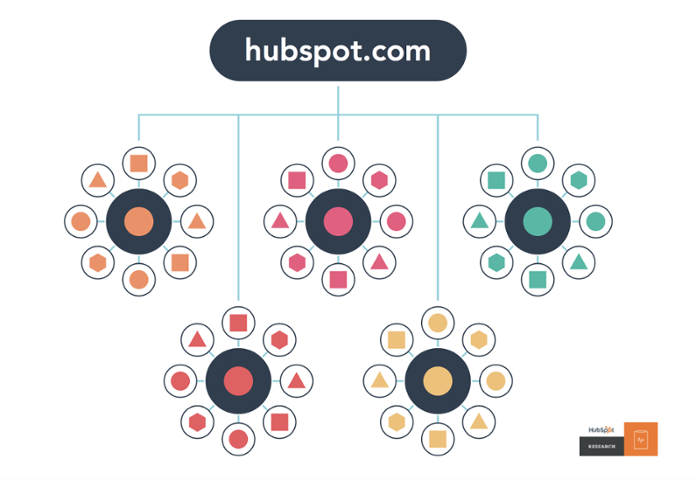SEO or Search Engine Optimization is a composition of many things. Some of the major aspects of SEO are keyword research, keyword implementation, meta information, on-page SEO, backlinks, website loading speed, etc. Although these are the topics that SEOs commonly talk about, they are not the only factors that affect a website’s rankings in the search engine results pages (SERPs).
In fact, there are 200+ search engine ranking factors that help determine a website’s search engine position.
One such important factor is the role of website structure, which then, directly and indirectly, affects many important areas of search engine optimization.
In this blog post, we are going to have an in-depth discussion about website structure, what it means, why it is important, and what are the best practices that you should follow.
What is website structure?
Website structure refers to how you organize and structure the contents and the pages of a site.
As you know, most websites usually contain a lot of web pages. These pages can be about the company (e.g., About us, Team, Mission Statement) or informative content (e.g., blog posts, white papers, case studies, interviews, industry news, etc.).
The structure of your website depends on how you organize these numerous web pages. A website owner usually has several tools that he or she can use to organize the pages on a site. These tools include:
- Keywords
- Categories
- Subcategories
- Tags
- Internal links
- Website navigation
Why is website structure important?
The structure of your website is important for a number of reasons.
First, as websites grow, they increase in size and the number of web pages. This leads to more cluttered websites that are difficult to navigate both for search engines and human visitors.
Unless your website is neatly structured — and all the different types of web pages are organized in a logical and sensible manner — it would be extremely tough for anyone (website visitor or search engine crawlers) to find information.
So, the structure of a website is important, because:
1. It helps search engine crawlers find and index web pages
One of the biggest goals of any website is to get ranked in the search engine results pages for relevant keywords and queries.
Sometimes, search engine crawlers cannot easily find, access, and index web pages on a site. It means that even if a web page is relevant to a search query, it may not be ranked on Google — because the search engine crawler could not find and index it.
If you have a well-structured website, it may help reduce the possibility of that happening. Search engine crawlers may find it easier to crawl and index web pages in a well-structured website.
2. It helps website visitors find the right content more easily
In modern-day SEO, user experience is a very important search engine ranking factor. Google would not want to rank your site higher in the SERPs if your website visitors do not have a good experience.
One of the biggest reasons why visitors may not have a great user experience on a site is the cluttered website structure.
If visitors cannot find the right page in the first couple of seconds, they may quit the website. This leads to a poor engagement rate: high bounce rate, low dwell time, etc.
All these factors are then considered by Google and other search engines to determine whether to promote or demote a website in the search engine results pages.
3. Possible keyword cannibalization
Keyword cannibalization refers to when a website has multiple pages discussing the same topic or targeting the same keyword or keyword phrase. Consequently, because multiple pages are targeting the same keyword phrase, traffic may be divided. This may also affect conversion rates and revenue.
Also, multiple pages on the same website may be competing with each other because they target the same keyword phrase.
A poor website structure is more likely to lead to keyword cannibalization issues. On the other hand, if there are distinct categories of topics and keywords, there would be fewer chances of multiple pages targeting the same keyword phrase.
Learn more about keyword cannibalization and how to solve it.
The best way to structure your website

Although there are several methods of structuring your website, the best practice is to have multiple levels or layers — each with a distinct definition.
These levels could be: the homepage, categories, and individual blog posts.
You can also organize your web pages by keywords or topics. Ideally, the site structure should look like a pyramid.
Pillars and Clusters
The pillar-and-cluster strategy is a relatively new one, but it may help you define and organize the content structure on your website.
This strategy has three components:
- Pillar content: A pillar content is a long-form piece of content (e.g., 5,000+ words) on a relatively broad keyword, e.g., fleet management solution.
- Clusters: Clusters refer to a bunch of supporting articles. These supporting articles are relatively shorter than the pillar content (e.g., 1,200 to 1,500 words) and target long-tail keywords, e.g., benefits of a fleet management solution, how to buy the right fleet management solution, how to increase efficiency with a fleet management solution, etc.
- Links: Internal links are an extremely important part of this strategy. A pillar post should be linked to each supporting article in a cluster and vice versa.
Ultimately, with multiple clusters (each focused on a certain topic and broad keyword), the website and content structure may look like this.
Image source: Hubspot
How to improve your website structure
Apart from adopting the pillar-and-cluster method to improve your website and content structure, you can also use the following tips:
1. Improve website navigation
The navigation of a website plays a very crucial role. Even if you do not have an intuitive website structure, a good navigation system will help visitors find the necessary information easily.
This will help improve the engagement rate on your site, which will likely have a positive impact on the site’s rankings in the SERPs.
2. Remove old content
Many websites have several outdated web pages that are no longer relevant, e.g., old promotions, flash sales, discontinued products. Remove such older pages.
3. Revisit categories and tags
As websites get cluttered, categories can become too large and bloated. It might be a good idea to revisit categories periodically and create more subcategories.
As a general rule, no category should be 2x the size of any other category.
4. Improve the internal linking structure
Make sure related web pages on your site are interlinked with each other.
A robust internal linking structure helps improve the bounce rate on the site. It may also help search engine crawlers find web pages more efficiently and effectively.
5. Have a sitemap
Having a sitemap can also make it easier for search engine crawlers to find and index web pages.
A smaller website does not necessarily need a sitemap. However, websites with lots of web pages should have one. A sitemap becomes especially important for websites that have too many isolated web pages.
“In most cases, your website will benefit from having a sitemap.” — Daniel Waisberg, Google.
Conclusion
Improving the structure of your website should be an ongoing process. Regularly revisiting it and identifying ways that can help you improve it can have a positive effect on the overall SEO performance of the site.
